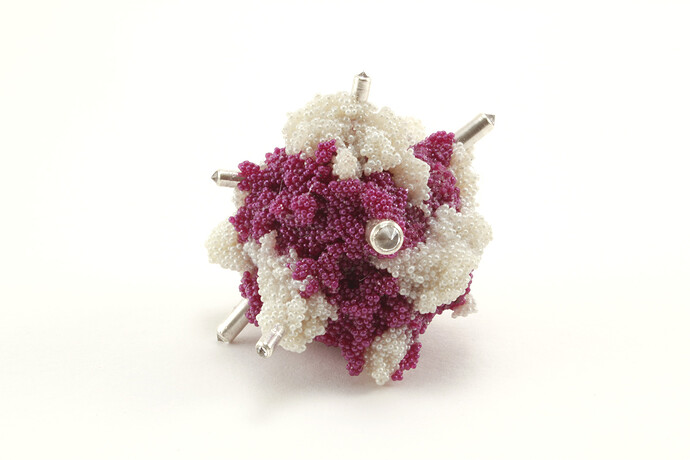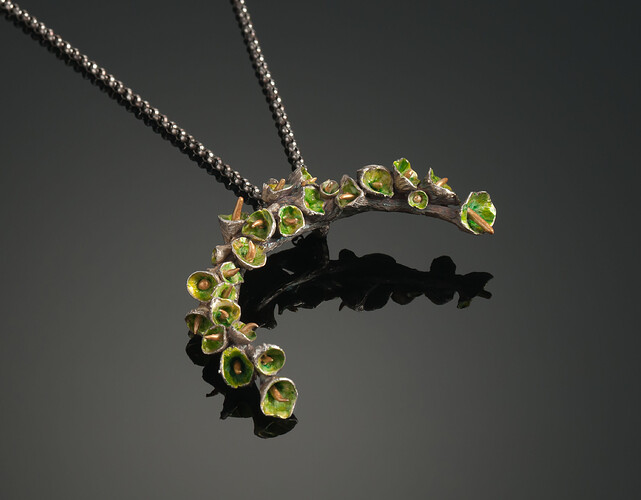Materials: Sterling Silver, Resin, Cubic Zirconia, Glass Microbeads,
Dimensions: 2"x2"x2"
This is a bead.
Photo credit: Erin Cora Turner
Jessica C Armstrong
Jessica Armstrong Jewelry Designs
Lancaster, PA. USA
Currently I am an emerging artist in Residence in the fine arts metals program at Millersville University and hold a Jewelry Marketing Internship with a fashion jewelry designer in New York City. I graduated with my Masters of Fine Arts from Edinboro University of Pennsylvania in May 2013 and with my Bachelor of Fine Arts from Eastern Kentucky University in 2010.
Moving across the country, I have encountered many different physical surroundings, and each of these shifts in landscape, both physical and emotional have shaped my work. With each of these changes of scenery, I?ve experienced new climates, people, relationships, and ways of thinking about my surroundings and myself. My jewelry is a response to these changes.
With the introduction of color, my work became boundless and found itself transformed. I began looking outside myself for inspiration, I began noticing novel elements of the landscape or climate and represented them in my work in a more literal way. For example, resin, glass microbeads and glitter became the cornices for icicles of a Pennsylvania snowstorm, or even caves visited in Kentucky or Tennessee. Chunky embossing powder references soil from my hometown, while chain and thread represents the link between the people living far away from me. Together, these layers create a representation and transformation of landscapes, people and relationships within my life. With the introduction of these particular found objects into my jewelry, I have been able to mimic physical and emotional states through tactile surfaces. This becomes an invitation to the viewer to take a second look, to delve deeper into each piece, and question what is really within the structure. I use jewel ry as a form of communication to express my relationships, topography, climate and landscapes, allowing me to wear my emotions, take them with me, in order to stay connected to my past, as well as be mindful of the present and possible future.
The exhibition explores metal works whose primary theme is color embraced as their primary visual focus, whether that be using colored materials, exploring creating colored surfaces, or encasing the object in color.
As the world's largest jewelry related internet site, Ganoksin strives to develop exhibitions showcasing work from around the world. This exhibition was open to all metalsmiths, professional and amateur, advanced and beginner.
In total 303 artists contributed 814 show pieces for the permanent online exhibition.
The exhibition was curated by Beth Wicker, President of the North Carolina Society of Goldsmiths in the United States, and Adjunct Instructor at Northeastern Technical College in South Carolina. Director of the exhibition is Hanuman Aspler, founder of The Ganoksin Project, the world's largest internet jewelry site.
Hue is one of the primary properties of color, it refers to the place the color occupies on the visual spectrum. Humans have used hues throughout time, to create cave paintings, to decorate themselves, their clothing and their housing.
Different hues have taken on different meanings throughout time. Gold traditionally has been a color of purity - the metal gold is relatively unchangeable, and the hue of gold has come to stand for gods and goddesses, for royalty, for durability and for purity. Red has often meant love, or passion. Hues often reflect the meaning of the seasons, with pastels referring to spring and the burst of new life after the pale hues of winter. Summer is reflected in vibrant, deep hues, followed by the browning of hues in the fall as plants go to seed and die, and the land turns fallow.
The worth of a hue has often been tied to what is necessary to make the pigment that creates the hue, and the expensive involved in the process. Often created from crushed stones that had to be mined and carried by caravan over thousands of miles, or from fermented roots of plants only grown in certain areas, or the carapaces of rare insects - the creation of hue in a way that could be used by man was an involved and generally expensive process.
In today's world metalsmiths have access to perhaps the widest range of materials and hues in the history of man - and in some of the most affordable ways ever.
This exhibition celebrates hue - color - as an integral, inherent element of the work. We talk of the "richness" of color, and examples of this abound here. One expects hues from the colors of gemstones used in metalsmithing, but we also have hues from some less expected places. Glass enamels are an ancient way of adding color, as are a variety of patinas. Today's artists also use synthetic man-made materials to add color in ways that didn't exist a century ago.
We invite you to enjoy this celebration of hue, and the ways hues and their use have changed over time.

